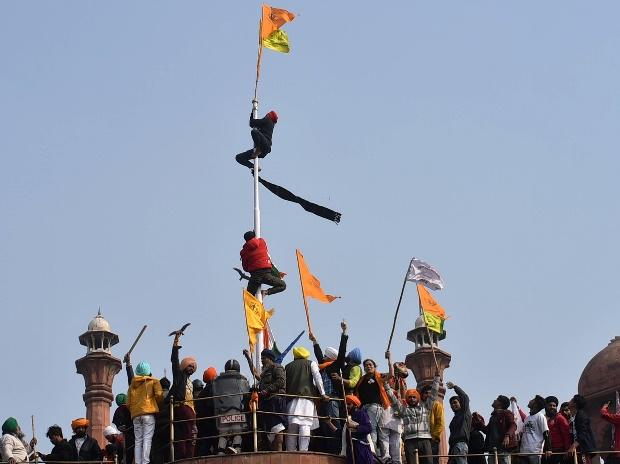
Red Fort should have reminded farmers violence destroys its practitioners

The Red Fort in Delhi teaches us many lessons. One of them should be immediately imbibed by farmers who turned violent during their protest march in Delhi on Republic Day and occupied the Red Fort.
More than any other monument in India, the Red Fort tells us that every act of violence leads to just one denouement: it discredits the perpetrators and undermines the very cause they are fighting for. In the end, violence destroys those who practise it.
On Tuesday (January 26), for only the second time in two centuries, a large number of people protesting against the State, occupied the Red Fort and unfurled their flags of rebellion.
The last time this happened was in May 1857, when Indian sepoys revolted against the British and occupied the Red Fort in a bid to exhort Bahadur Shah Zafar to become their leader and announce a parallel government.
Related news: Farmers removed, Red Fort locked; Amit Shah to review situation
It is unlikely the sepoys would have succeeded in driving the mighty British out under the leadership of an old emperor whose influence did not extend beyond the Red Fort. But, the sepoys made a fatal error that hastened their demise.
On May 16, the sepoys captured around five dozen Europeans, including women and children, and slaughtered them at the Red Fort, in spite of Zafar’s orders that the prisoners not be harmed.
This act of wanton violence led to two fatal consequences. One, it deprived the sepoys the support of Delhiwallas, who immediately became suspicious of the rebels, locally referred to as purbias. And two, it gave the British the provocation to raze Delhi, massacre the rebels and destroy the Mughals.
On January 26, farmers who repeated the mistake made by the sepoys in 1857 at exactly the same venue, undermined their own cause with the needless act of indiscretion and clashes with the police. They now run the risk of losing whatever little sympathy they had among urban Indians and giving the government a reason for breaking down their movement with use of force and punitive action.
Contrary to what many would believe, the State fears nothing under the sun more than a non-violent, peaceful agitation. Since most governments are programmed to treat a mass movement as a nuisance that needs to be crushed, they become jittery when they do not get the opportunity to use their batons, pellets and tear-gas guns. But, any act of violence initiated by the protesters is manna for them–it gives them the moral and administrative right to react with unequal force.
For more than two months, farmers had kept the government on a leash with their non-violent protest against farm laws. Due to their restraint, discipline and adherence to ahimsa, even the Supreme Court didn’t order the government to evict the protestors, or pass strictures against leaders of the agitation.
A few hours of anarchy in Delhi will deprive farmers of the legitimacy and political equity they had. It would divest them of the moral ascendancy they had attained by camping peacefully on the outskirts of Delhi. As a popular couplet by Muzaffar Razmi goes: Ye jabr bhī dekhā hai tārīḳh kī nazroñ ne, lamhoñ ne ḳhatā kī thī sadiyoñ ne sazā paaī (We witnessed even this travesty through the eyes of history that aeons paid the price of mistakes made by a few moments). Farmers would certainly rue this moment of anarchy.
The Sikhs should have known that violence is a game of diminishing returns from their own history. They have, after all, been at both ends of the barrel at many points in Indian history. As victims of the Jallianwala Bagh massacre, they had seen the British being shamed; as victims of the Delhi riots in 1984, they had earned the sympathy of India and the world; and they had witnessed the demise of the Khalistan movement after it passed into the hands of Bhindranwale and his men. It is a pity, history has to repeat its lessons every few years.
It is also a shame that all mass movements in India usually turn violent, unless restrained by a leader who has massive political and moral heft, a lesson Mahatma Gandhi learnt after Chauri Chaura. And nobody would know this better than the BJP, which would be watching the drama in Delhi with a bitter sense of deja-vu.
The sight of farmers unfurling their flag at the Red Fort is symbolically as eerie as the sight of kar sevaks atop the disputed shrine in Ayodhya on December 6, 1992. This, in many ways, is Babri redux.
Back then, the BJP had promised a peaceful kar seva at the dispute site and even assured the Supreme Court of its compliance with the law of the land. In the end, the sevaks razed the structure, leading the then prime minister PV Narasimha Rao to call it an act of utter “perfidy”.
Related news: Not all quiet on western UP front for BJP due to farmers’ stir
The Delhi police may be left with a similar feeling of betrayal by farmers who had promised a peaceful tractor rally on a pre-decided route. But, the anarchy in Delhi once again underlines the tragic point that leading a mass movement in India is like riding a tiger. (This is precisely why Einstein said generations to come would scarcely believe someone like Gandhi ever walked in flesh and blood.)
Unfortunately for them, the farmers do not have a Gandhi to help them regain what they have lost. Unless there is a miracle, this could be the beginning of the end of the kisan andolan, at least as a moral, ethical and non-violent struggle against the government.

